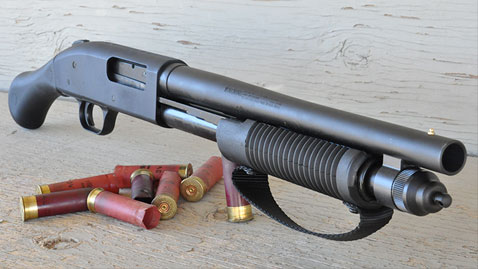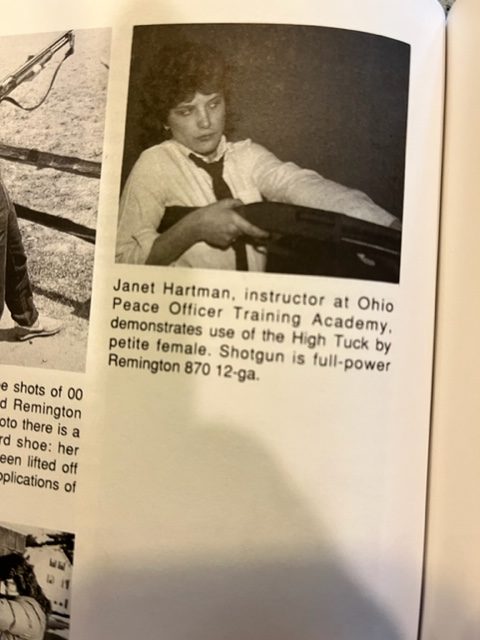I got a question from a reader about short barrelled, stockless “shotguns” that are technically classified as “firearms” allowing them to have shorter barrels than weapons classified as “shotguns.” They are very popular weapons and have been made in mass quantities by both Mossberg and Remington.
“What are your thoughts on a ‘hipfire’ type shotgun like the Mossberg 590 Shockwave as a home defense firearm? Specifically, not in any NFA format.
Would this be risky/foolish even with a lighted forend and an aiming assist like a Crimson Trace laser?
For context, this question arises out of your recent, excellent article about shotguns for home defense.”
I’m generally not a fan of those kind of guns for most people.
Having a stock will increase speed, accuracy, and recoil control. Most people need as much of that as they can get.
With that said, if someone is willing to put in hours and hours of practice mastering the stock-less shotgun, they will probably fare well in most close range or indoor encounters. The laser makes that an even better possibility.
The short overall length makes it very useful for travel. And if one can shoot the gun well, the shorter overall length will help with firing from vehicles or in very close quarters.
But even if you get good with the stockless shotguns, you’ll still almost always shoot better with a shotgun that has a stock. In particular I’m discussing guns like the Mossberg Shockwave and the Remington Tac-14 that have a “birdshead” style grip.

Remington Tac-14 with birdshead grip
I am not talking about the shotguns that have been available for decades with full-length barrels and pistol grips. The traditional pistol grip and longer barrel negates a lot of the advantages of the birdshead grip stockless shotgun. The grip angle makes it much harder to control recoil as compared with the newer grip design.
I generally don’t recommend the newer stockless “firearms.” The older pistol gripped shotguns are even far worse. Rhett Neumayer of Demonstrated Concepts explains this idea in depth in his video Short Barrel Shotgun SBS vs. Birdshead Grip for CQB CQC.

Traditional 870 with pistol grip. Even worse than the new versions
One other issue that few consider is that many indoor shooting ranges won’t allow the stockless shotguns to be fired on their premises. That might make your practice sessions a lot more difficult.
An additional disadvantage of the stockless weapons is that they may be more difficult to equip with a quality sling. I prefer to have a sling on my shotguns for both retention advantages and the easier ability to transition to an alternate weapon should I encounter a malfunction or run out of ammunition.
Overall, I think that those guns have a certain niche (namely in vehicles) where they work well if they are handled by an operator who has mastered their unique challenges.
For 90% of the scenarios you might envision, the shotgun with a regular stock will be a better defensive choice.
One additional clarification. “Hip fire” isn’t the answer. There are better ways to mount the stockless shotguns. One method pioneered by Rhett Neumayer is utilizing the combination of push/pull recoil control, an alternate grip with the support hand, a recoil strap, and indexing the grip against the shooter’s cheek.
Sound funny? Watch how quickly Rhett gets his shots off in the video below.
12 gauge. Stockless. Braceless. Recoil Strap
Rhett explains in detail how he shoots the stockless “shotguns” faster than most people shoot guns with full stocks in the video below. If you want to fully embrace the stockless shotguns, I would advise that you practice his methodology.
Birdshead Grip Shotgun How to Shoot/Setup
For information on the topic from other experts, I commend your attention to the following article and video.
The Mossberg Shockwave by Gunsite’s Ed Head

Why I Stopped Hating the Shockwave (And Other Stockless Shotguns) by Lucky Gunner.
The reader continued by asking an additional question about the actual disadvantages of a fully stocked shotgun.
“The motivator for buying the Shockwave and asking my question is, mainly – the stark comparison in close-range usability between that unique firearm and a regular, stocked 590 18” (37” OAL) that I’ve owned for a very long time. I don’t otherwise seek out firearms that I expect *not* to aim traditionally.
The 37-inch-long 590 is an excellent firearm, but its size seems quite unwieldy for the close quarters of my current suburbia home and most places I’ve lived previously. When shouldered, it seems like it would bang against walls and doorways under the clumsiness of adrenaline. It also seems like the muzzle would enter a room long before I do… Of course, that assumes a scenario where I’m “room clearing” (in a very loose sense) amid an active threat. Rather than simply waking up to investigate a noise (gun not shouldered), or dealing with an obvious threat closing in directly. (Also, I do know that any form of room clearing in general is likely to be tactically questionable, and very dangerous, even for the trained pro which I am not.)
In typing this all out, I’m now questioning my own prior assumptions about how much the extra length of the 37” shotgun would make a noticeable hindrance in any of the likely home-defense scenarios. Perhaps not much.”
In response to this inquiry, I will state that I spent most of the first 2/3 of my police career searching buildings with fully stocked rifles and shotguns. They were more difficult to manage in very tight situations, but using the concept of “short stocking” or using the “High Tuck” position once taught in police shotgun classes, some of the length disadvantages could be mitigated.

The “High Tuck”
The photo above is from Massad Ayoob’s 1992 book “Advanced Combat Shotgun.” Note where the photo was taken. I was certified as a shotgun instructor by the Ohio Peace Officer Training Academy in the late 1990s and was actually taught this technique by the instructor in the photo (who has now been retired almost 20 years). You can imagine that it really didn’t work very well.
As my career progressed, I got heavily (no pun intended) into powerlifting and swelled in size to 265 pounds. Those tight hallways got even tighter. You know what I did? I simply utilized my pistol for any structural search or vehicle application. During the one active killer situation to which I responded in my career, I had to search for the killer in the basement of a house where she had just shot two people. Officers with me offered their carbines. I chose the pistol, even actively hunting an armed murderer.
I’m retired now and not quite so large. My bedroom home defense weapon is a NFA-registered short barrel shotgun. Even with the reduced length, I still wouldn’t choose it if I had to move from my barricaded bedroom. If I had to clear my apartment, the Glock 19 with the Surefire light in my night table will be the weapon I choose.
Short barrelled and stockless shotguns are quite handy, but they aren’t as handy as a pistol. I choose to do all my structure clearing work with my handgun rather than use a short rifle or shotgun.
You’ll have to make your own decision. I will only share the fact that the students I see in shotgun classes generally perform better with a shotgun that has a stock.

